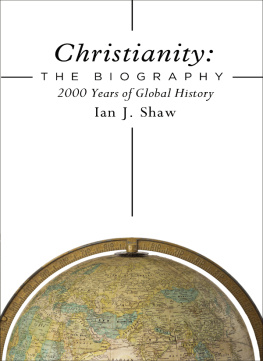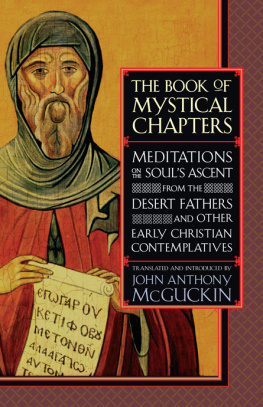InterVarsity Press
P.O. Box 1400, Downers Grove, IL 60515-1426
ivpress.com
2017 by John Anthony McGuckin
All rights reserved. No part of this book may be reproduced in any form without written permission from InterVarsity Press.
InterVarsity Pressis the book-publishing division of InterVarsity Christian Fellowship/USA, a movement of students and faculty active on campus at hundreds of universities, colleges, and schools of nursing in the United States of America, and a member movement of the International Fellowship of Evangelical Students. For information about local and regional activities, visit intervarsity.org.
All Scripture quotations, unless otherwise indicated, are the authors translation.
Cover design: David Fassett
Images: Christ Pantocrator, Byzantine School, Monastery of Saint Catherine, Mount Sinai, Egypt / Photo Zev Radovan / Bridgeman Images
ISBN 978-0-8308-9952-4 (digital)
ISBN 978-0-8308-4098-4 (print)
Library of Congress Cataloging-in-Publication Data
Names: McGuckin, John Anthony, author.
Title: The path of Christianity : the first thousand years / John Anthony
McGuckin.
Description: Downers Grove, IL : InterVarsity Press, 2017. | Includes
bibliographical references and index.
Identifiers: LCCN 2017000167 (print) | LCCN 2017000761 (ebook) | ISBN
9780830840984 (hardcover : alk. paper) | ISBN 9780830899524 (eBook)
Subjects: LCSH: Church history--Primitive and early church, ca. 30-600. |
Church history--Middle Ages, 600-1500.
Classification: LCC BR165 .M35 2017 (print) | LCC BR165 (ebook) | DDC
270--dc23
LC record available at https://lccn.loc.gov/2017000167
CONTENTS
Jewish Christian groups
Encratites
Nazarenes (Nazoraioi)
Ebionites
Elkesaites
Montanism
Asia Minor Quartodeciman communities
Christian gnosis
A context
Valentinus (fl. 120160)
Bardesanes (c. 154222)
Basilides (fl. 135161)
Marcionism
Irenaeus of Lyons (c. 135200)
The apostolic fathers
Clement of Rome and the pseudo-Clementines
Ignatius of Antioch (c. 35107)
Hermas (active 90150)
Polycarp (c. 69156)
Papias of Hierapolis (active early second century)
The Letter of Barnabas
The Didache
The Letter to Diognetus
The second- to third-century Monarchian movement
The anti-Monarchian early Logos school
Justin Martyr (d. c. 165)
Tertullian (c. 155220)
Hippolytus (c. 170235)
Novatian of Rome (c. 200258)
Neros persecution
Domitians persecution
Trajans persecution
The Severan interlude
The persecution of Maximinus Thrax
The Decian persecution
The persecution of Valerian
The Diocletianic persecution
The memory of a persecuted community
The principate and dominate (27 BC to AD 313)
A Christian response to Roman oppression: Tertullians social theology
Mithras
Isis, queen of magic
Cybele
Manichaeism
Justin Martyr (d. c. 165)
Tatian
Athenagoras of Athens (c. 133190)
Melito of Sardis (d. c. 180)
Clement of Alexandria (c. 150215)
Theophilus of Antioch
Tertullian (c. 155240)
(Marcus) Minucius Felix (later second century)
The Alexandrian catechetical school
Origen of Alexandria: Master theologian and philosopher
Origens biblical theology of salvation
Origens heritage: Dionysius of Alexandria
The school of Caesarea
Arius and Alexander in conflict
The Council of Nicaea 325
Searching for commonality and consensus
The Synod of Serdica 343
The Synod of Alexandria 362
Athanasiuss opponents
Eusebius of Nicomedia
Aetius and Eunomius of Cyzikos
Basil of Caesarea (330379)
Gregory of Nazianzus (329390)
Gregory of Nyssa (c. 331395)
Eastern penitential canons
The Synod of Ancyra 314
Monastic influences on penance
Western penitentials and the system of confession
Feudal ideas of restitution and expiation
Purgatory as posthumous expiation
Feudal atonement theory in the West: Anselms Cur deus homo?
The emergence of varieties of Christian monasticism
Syrian monasticism
Aphrahat the Sage
Macarius the Great
Mar Isaac of Nineveh
Symeon Stylites
Egyptian monasticism
Tales of Antony
Tales of the desert: The Christian fayyum
Pachomian federated monasticism
Other notable Egyptian monastic centers: Gaza and Sinai
Monasteries in Palestine and beyond
Euthymius
Mar Saba
Early monasticism in the West
Martin of Tours
John Cassian in Marseilles
Irish monasticism
Columba
Columbanus
Hilary of Poitiers
Ambrose of Milan
Augustines City of God
Augustine and the Donatists
Pelagius
Caelestius
John Cassian
Jerome and his agenda
Pope Damasus
Popes Felix and Leo
The Acacian schism
The Vandal kingdom
Boethius among the Ostrogoths
The clash of Antioch and Alexandria
The reform campaign of Nestorius at Constantinople
Cyril of Alexandrias countercharge
The Council of Ephesus 431
Ephesus II 449 and its aftermath
Damascius of Athens and the neo-Platonic school
Dionysius the Areopagite
The Digest (or Pandects) of Justinian
The Institutes of Justinian
The Novels of Justinian
Justinians Corpus Iuris Civilis
Eucharistic
Baptismal rites
Penitential rites
The African rite
The Ambrosian rite
The Mozarabic rite
The Gallican rite
The Celtic rite
The Antiochene liturgical family
The Alexandrian liturgical family
John Mauropous
Constantine (Michael) Psellus
John Xiphilinus
Constantine Leichoudes
Pre-third-century writers
Origen
Lactantius
The fourth-century Fathers
Augustine
Byzantine attitudes
Latin hymns
Pre-sixth-century Syro-Byzantine hymns
Apostles
Christian prophets
Presbyters
Bishops
Deacons
Widows
Virgins
Scriptural evidences
A tradition rooted in eschatology
Wealth in the earliest centuries of the church
The patristic-era teachings
The Jesus tradition
The Pauline and Pastoral Letters
The patristic era: The triumph of renunciation theory















